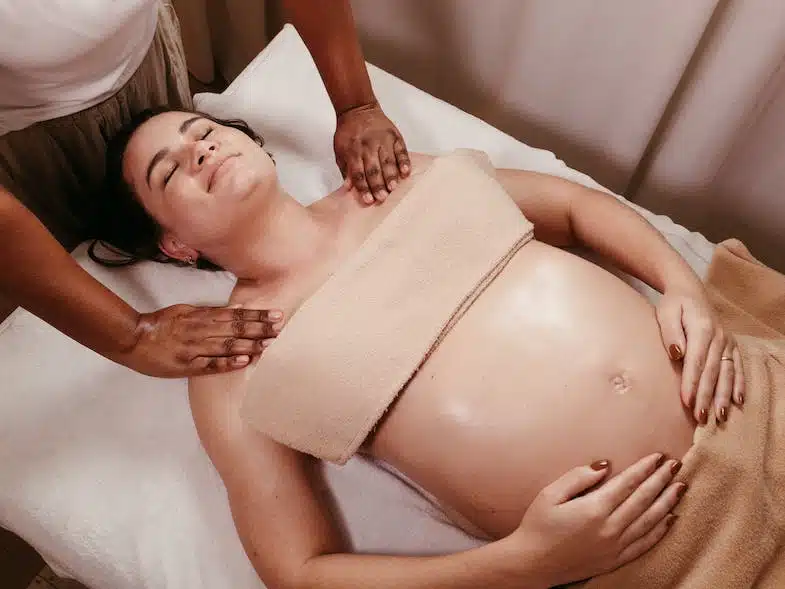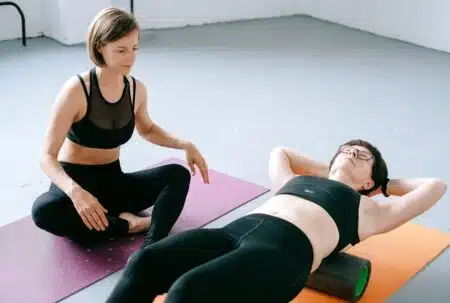As your third trimester unfolds, excitement over your approaching due date likely mingles with anxious hopes for an uncomplicated labor and smooth delivery. Preparing your body to expand optimally when those first contractions hit proves vital to avoiding excessive perineal trauma as the baby descends through the birth canal. This is where the incredible benefits of perineal massage come into play.
When performed regularly from 34 weeks onward, perineal massage gently conditions the tissues between your vaginal opening and anus to safely stretch as your baby crowns. By manually increasing mobility and elasticity within these intimate muscles beforehand, you significantly reduce risks of extensive vaginal tears or needing episiotomy incisions that require postpartum stitches.
Understanding the Perineum’s Pivotal Role
The perineum, which is the region between the vaginal opening and anus, must dramatically thin and expand to allow your baby to pass through the birth canal during the stage of labor. This intricate network of muscles, fascia, nerves, and blood vessels need to efficiently stretch not just width-wise but also length-wise to accommodate childbirth. A systematic review and meta-analysis of healthcare literature suggests that antenatal perineal massage helps to prepare your body for this birth journey.
Without proper preparation, excessive resistance from thick, inflexible tissues often leads to tearing traumas or clinicians making surgical cuts (episiotomies) to widen the opening. Both tearing and episiotomy incisions usually require postpartum stitches to repair damage. Resulting perineal scarring frequently causes uncomfortable intercourse, urinary incontinence and even fecal incontinence if muscles fail to heal cohesively.
How Perineal Massage helps Prevent Tearing Damage
The core goal of antenatal perineal massage involves manually replicating the stretching and pressure sensations that will occur when your baby’s head crowns during labor, aiming to reduce the risk of a perineal tear. By gently tractioning the tissues surrounding your vaginal opening inwards, then downwards toward the perineal muscles during a regular perineal massage, tight spots progressively release chronic holdings as the range of motion expands.
You can visualize this as gently elongating rigid rubber bands, which may reduce the risk of a perineal tear during childbirth. Relaxing contracted zones decreases resistance your baby meets exiting the womb. Regular massaging sessions essentially act as “warm up stretches” for your nether regions to avoid overtaxing the muscles.
By gradually restoring flexibility through sustained tractioning of tight areas, the perineum relearns to smoothly stretch open with the help of antenatal perineal massage, rather than stubbornly resisting expansion, thereby potentially lowering the risk of perineal tear during childbirth. This protects delicate nerves interlaced throughout the muscles from getting over-compressed.
Incorporating Perineal Massage Into Your Pregnancy Self-Care
Ideally begin massaging your perineal tissues every 2-3 days starting at week 34, continuing right up until your due date or until reaching full term feels too physically awkward given your belly’s size. Let comfort guide your ultimate massage duration each session, progressively building from 30 seconds towards smoothly holding pressure for up to 5 minutes as the tissues release tightness.
To avoid vaginal infection or perineal tear, always wash your hands thoroughly and keep nails trimmed short before massaging your perineum internally. To make the massage more comfortable, sit, lie down, or prop up with pillows in positions that feel most relaxed through the hips, buttocks and thighs instead of clenching these muscle groups. Consciously breathe deeply throughout the entire regular antenatal perineal massage process as you prepare for childbirth. Your mindset matters tremendously here – tension, anxiety, and breath holding will all sabotage your body’s efforts to soften and open during childbirth. Regular perineal massage may help alleviate some of these concerns.
Repeatedly remind yourself that your vagina truly does expand beautifully during labor to allow your baby to gently emerge into the outside world. Make this a loving mental mantra while massaging.
Massage Technique Basics
After applying a generous amount of natural oil, use moderate inward tractioning pressure from your thumb or fingers to gently pull the upper vaginal walls laterally side to side first before moving your attention lower. Traction by curling fingers inside and intentionally pulling up or outwards away from the vaginal opening while pressing digits deeply into tight spots for 30 seconds up to several minutes until the region softens.
Slowly work way down towards the bottom vagina and perineal muscles using the same tractioning approach. Targeting upper vaginal regions first proves important since the lower vagina and opening easily expand right before birth.
Actively focus on visualizing and feeling the tissues lengthening when you massage the perineum, like slowly stretching an expanding rubber band. Remember, perineal massage shouldn’t hurt. Thus, if any stretching sensations feel too intense, immediately ease up on pressure intensity while consciously breathing into releasing residual tension held there. After performing the massage over time, you will notice previously shortened, stubborn spots start to release tightness, lowering the risk of tearing and elongation to gracefully accommodate the birth of your baby later.
Optional Perineal Massage Tools
Some women prefer using bespoke perineal massage tools for added comfort reaching internally and find that starting perineal massage with these can make the process less daunting. Easy-grip handles with rounded fingertip surfaces provide leverage accessing tight spaces that prove difficult to contact using fingers alone. To simplify cleaning, look for seamless designs, especially when choosing your massage oil bottles. While not mandatory, these handy self-care aids let you target massage pressure more precisely. These tools can be particularly useful during your last week of pregnancy, when preparing for childbirth with a regular perineal massage routine.
Involving your Birth Partner
Consider inviting your birth partner to assist massaging when available to educate them on stretching your vaginal terrain firsthand. This insight about the birthing process calms anxiety about babies emerging from the seemingly tiny opening during the stage of labor. By directly witnessing your incredible expandability, their confidence in your body’s innate capacity grows.
Simultaneously, intimate encouragement through hearing “Your body is beautifully opening up to welcome our baby” while receiving the massage promotes positive psychological readiness. Remind partners to avoid penetrating fingers internally while helping to massage your perineum to prevent introducing bacteria leading to vaginal infection. External tractioning still conditions the area effectively.
Help with Perineal Massage during Pregnancy
Scheduling prenatal appointments with a pelvic floor physical therapist supercharges perineal massage benefits by expertly locating and releasing exceptionally rigid spots using techniques hard to replicate solo. They manually assess your unique anatomy and restrictions for accurately targeting treatment, understanding when and how to perform the massage effectively. This optimizes self-massage sessions at home between visits,
During their checks, physical therapists also carefully look for separations in perineal connective tissues that could possibly compromise capacity later. Applying massage oil can make this assessment less uncomfortable. Catching problems early allows implementing interventions improving integrity before the intense stretching of labor begins. Ensure any specialist you see specializes in pre/postnatal care, including antenatal perineal massage, for ideal support during pregnancy and childbirth.
Empower Your Body Through Perineal Massage
While no guarantees exist against tearing during delivery, diligently massaging with patience, mindfulness and correct techniques substantially improves your chances of avoiding extensive perineal trauma when the baby descends. Rather than passively waiting as your due date approaches, take control of preparing your body through simple self-care rituals that gently amplify your tissues’ flexibility allowing your baby’s smooth passage into your waiting arms.



